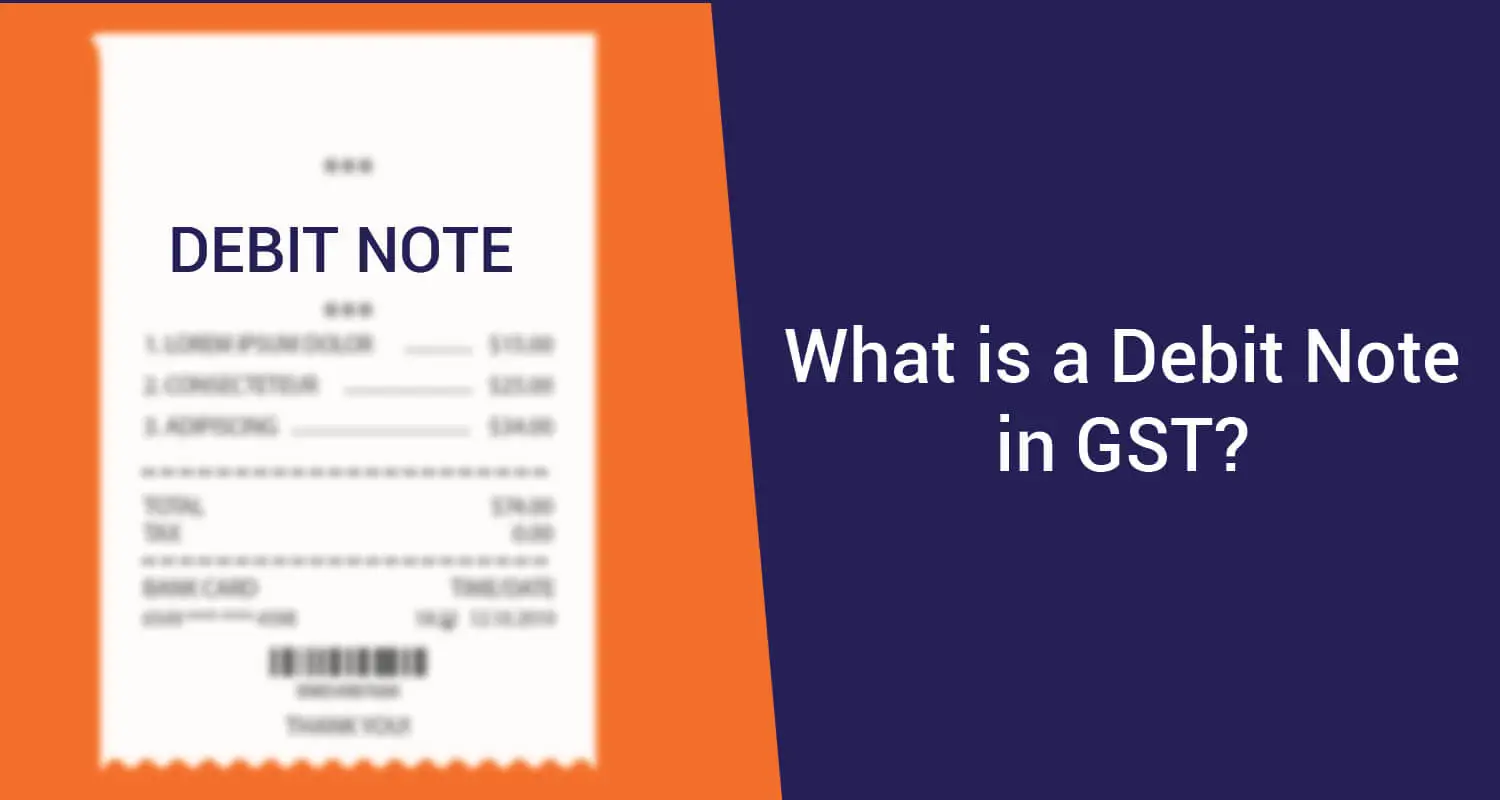What is Debit Note in GST?

The advent of the GST regime brought with it the concept of a ‘Debit note.’ A debit note is crucial for adhering to accounting standards in the Indian SME manufacturing business. Common in B2B transactions, it rectifies accounting errors. Buyers and sellers of all scales use it, and it addresses inaccuracies inherent in business dealings. So, exactly how does the debit note work, and what is the debit note meaning? Let’s read further to understand.
What is a Debit Note?
A debit note (or a debit memo) is issued post-sale when an invoice needs alterations. It's a commercial document utilized by the buyer or seller after completing a transaction. Here's a brief overview of why these notes may be issued.
Issued by a seller:
- Invoice requires adjustment- The seller provided the buyer with an invoice after delivery but mistakenly billed a lower per-unit price.
- Incorrect tax rate- The invoice reflects a 12% GST instead of the correct 18%, necessitating correction.
- Total invoice amount discrepancy - Though unit prices are accurate, the total due must be corrected and issued correctly.
Issued by a buyer:
- Invoice discrepancy: Although the sale is finalized and invoiced, the amount listed by the seller is inaccurate.
- Goods damaged upon delivery: Post-delivery, the buyer discovers some items received are damaged.
- Cancellation of transaction: Unforeseen circumstances may necessitate the buyer to cancel the purchase and return the goods to the seller.
Sapna aapka. Business Loan Humara.
Apply NowDebit note Format
As an SME manufacturer in India, there isn't a prescribed debit note format to adhere to, but authorities deem certain fields essential. These include:
- Company Details: Supplier and buyer names, addresses, and GSTIN.
- Serial Number: An alphanumeric sequential code specifying the unique serial number for the debit note.
- Associated Invoice Number: The alphanumeric sequential code of the corresponding invoice.
- Relevant Dates: Invoice creation date and debit note issuance date.
- Detailed Descriptions: Comprehensive accounts of goods' details and descriptions.
- Legally Authorized Signatures: Signatures of authorized representatives from the issuing party.
Debit note in GST
According to Section 34(3) of the CGST Act 2017, a goods and services supplier can issue a debit note in various scenarios:
- when a tax invoice is issued for services or goods, but the taxes charged are lower than the actual taxable value;
- when the quantity of goods/services supplied exceeds the initially agreed commitment;
- or when issuing a tax invoice for the supply of goods/services.
The role of a debit note in GST comes into the picture when it forms an important part of the details mentioned in GSTR-1 for the month in which the said supply was made and when the same information is seen reflected in Form GSTR-2A and GSTR-2B for the recipient's review and submission in GSTR-3B.
Previously, reporting a credit or debit note required quoting the original invoice number on the GSTN portal in Forms GSTR-1 and GSTR-6. However, the amendment delinking debit notes from their original invoices lead to the following changes:
- Provided place of supply in the note helps in identifying the type of supply- intrastate or interstate supply
- A debit or credit note issued for a tax rate difference can have a value of zero, as entering the correct tax amount will suffice.
Amendment influenced Input Tax Credit (ITC) treatment. Pre-amendment, the time limit to claim ITC (Income Tax Credit) was tied to the invoice date, but post-amendment, it aligns with the debit note issue date.
For instance, check this debit note example: if an invoice was issued in February 2020 and the debit note in August 2020, the ITC claim deadline would be the due date of Form GSTR-3B for August 2021, given the debit note's 2020-2021 issuance.
Step-by-step guide on creating a debit note
Creating a debit note involves the following steps:
- Date and Number: Specify the date and assign a unique debit note number.
- Recipient Details: Address the note to the recipient, including their name, address, and contact details.
- Your Company Information: Include your company's name, address, and contact information at the top.
- Reference: Reference the original invoice or purchase order related to the debit note.
- Description: Provide a detailed description of the goods or services, including quantities, unit prices, and total amounts.
- Reason for Debit: Clearly state the reason for issuing the debit note, such as returned goods or overcharges.
- Total Amount: Calculate the total debit amount, ensuring it matches the discrepancies described.
- Taxes: Include any applicable taxes and the revised total amount.
- Signature and Contact: Sign the debit note and provide a contact person for further inquiries.
- Distribution: Send the debit note to the recipient and retain a copy for your records.
Importance of debit note under GST law
The Goods and Services Tax (GST) law mandates the use of debit notes for specific situations in business transactions. A debit note, issued by a seller (supplier) to a buyer (recipient) formally increases the amount owed on a previous purchase. This document plays a vital role in ensuring:
- Accuracy of Records: Debit notes rectify errors in original invoices, such as miscalculations or missing charges, leading to accurate financial records for both parties.
- Transparency in Transactions: They provide a clear and documented trail for any adjustments made to the initial invoice amount, fostering transparency in business dealings.
- Compliance with GST: Issuing debit notes for legitimate reasons like additional charges or revised tax rates helps businesses adhere to GST regulations and avoid potential penalties.
- Claiming Input Tax Credit (ITC): For the buyer, accepting a valid debit note allows them to claim the increased input tax credit (ITC) associated with the additional amount, optimizing their tax benefits.
Time Limit for issuing a debit note
While there's no strict deadline for issuing a debit note in GST, it's essential to maintain clear communication and adhere to record-keeping requirements. Here's what you need to know:
- Issuing Promptly: While not mandated, it's recommended to issue a debit note as soon as the need arises to avoid confusion and ensure timely record updates.
- Reporting Window: The debit note must be reflected in your (supplier's) GST return (GSTR-1) for the month it's issued. This ensures proper tax calculations and reporting.
- Impact on Recipient: The recipient has the option to accept or reject the debit note. For them to claim the increased Input Tax Credit (ITC) associated with the adjustment, they must accept it within a specific timeframe.
When a debit note is issued?
Debit Notes can be issued without a specified time limit and must be reported in GST returns. They should be included in the return for the relevant month and submitted
- before September following the end of the financial year in which the supply occurred or
- before the filing of the Annual return,
whichever comes first. Tax liability must be adjusted according to prescribed guidelines.
Debit notes or supplementary invoices must be kept for seventy-two months from the annual return's due date for the relevant year. If these records are maintained manually, they should be stored at each business location listed in the registration certificate and be accessible at digitally maintained locations.
Process of issuing a debit note
Here's the process for issuing a debit note:
- Initiation: You, as the supplier, create a debit note detailing the reason for the increase. This could be due to additional charges, miscalculations in the original invoice, or revised tax rates.
- Content: The debit note should clearly state:
- Your company information (including GSTIN)
- Recipient's information (including GSTIN)
- Reference to the original invoice
- Reason for the increase
- Revised amount with applicable GST
- Issuance: You formally send the debit note to the recipient.
- GST Reporting: You include the debit note in your GSTR-1 for the month it's issued.
- Recipient Action: The recipient receives the debit note and reviews it. They can accept the adjustment, impacting their tax liability.
- Impact on Recipient: Upon acceptance, the recipient can claim the increased Input Tax Credit (ITC) in their GSTR-3B.
Reasons for issuing a debit note
There are several reasons why a debit note might be necessary:
- Errors in the Original Invoice: If the original invoice contained mistakes, such as undercharged amounts due to miscalculations or missing charges, a debit note can rectify the error.
- Additional Charges: If there were unforeseen expenses incurred after the initial invoice was issued, such as additional freight costs or handling fees, a debit note can be used to reflect these.
- Changes in Tax Rates: In rare instances, if the tax rate applicable to the purchase changes after the initial invoice, a debit note can be issued to reflect the new tax amount.
Did the 2018 amendments affect any rules regarding debit notes?
Amendments brought about significant changes, including:
- Recipients under GST cannot issue credit or debit notes; this process solely flows from the supplier.
- Multiple credit or debit notes for a single tax invoice are now permissible.
- Conversely, one credit or debit note can be applied to multiple tax invoices.
- It's essential to note that credit or debit notes must be aligned with the financial year and cannot span across multiple financial periods.
Conclusion
A debit note is a crucial accounting document required in many business transactions. Businesses maintain a separate debit note book to keep the record and two copies of the note for each of the involved parties. The note makes it easier and more systematic to keep track of transaction value changes and claim ITC accordingly.
If you are also in the small business or SME Manufacturing sector, you will need a thorough knowledge of debit notes. You can head straight to IIFL Finance blogs to stay updated about more such terms and to avail yourself of business loans for all your business purposes.
FAQs
Q1. What's the difference between debit note and credit note in gst?Ans. In GST, debit notes (issued by buyer) increase the amount payable due to returns, extra charges etc. Credit notes (issued by seller) decrease the amount payable due to returns, discounts etc. They are like adjustments to the original invoice. (59 words)
Q2. How to upload debit note in gst portal?Ans. You cannot directly upload debit notes in the GST portal. Debit and credit notes are reported in your GST return filings (GSTR-1).
Here's how the reporting works:
- Registered recipients (B2B): Include debit note details in Table 9C - Amended Credit/Debit Notes (Registered) of your GSTR-1 form. You'll need information like recipient's GSTIN, original invoice details, and the reason for the debit note.
- Unregistered recipients (B2C): Report debit notes in Table 9B - Credit/Debit Notes (Unregistered) of your GSTR-1 form. This requires details like original invoice information, debit note value, and the reason for the debit note.
Ans. Under GST, only the supplier can issue a debit note. However, the recipient can inform the supplier about the reasons for requiring a debit note (e.g., damaged goods received).
Q4. How does a debit note affect GST filing?Ans. Both the supplier and the recipient need to report the debit note in their respective GST return filings (GSTR-1).
- Supplier: The supplier includes the debit note details in their GSTR-1 to reflect the increased tax liability.
- Recipient: The recipient reflects the debit note information if they want to claim the increased input tax credit (ITC) arising from the higher taxable value.
Ans. There's no specific deadline for issuing a debit note in GST. However, it's advisable to issue it as soon as the reason for the adjustment arises to avoid discrepancies in GST filing.
Q6. What are the benefits of using debit notes?Ans. Using debit notes ensures transparency and accuracy in GST transactions. They help:
- Suppliers: Claim the correct tax amount on the increased invoice value.
- Recipients: Claim the eligible ITC based on the revised taxable amount.
- Both parties: Maintain proper accounting records and avoid future disputes.
Sapna aapka. Business Loan Humara.
Apply NowDisclaimer: The information contained in this post is for general information purposes only. IIFL Finance Limited (including its associates and affiliates) ("the Company") assumes no liability or responsibility for any errors or omissions in the contents of this post and under no circumstances shall the Company be liable for any damage, loss, injury or disappointment etc. suffered by any reader. All information in this post is provided "as is", with no guarantee of completeness, accuracy, timeliness or of the results etc. obtained from the use of this information, and without warranty of any kind, express or implied, including, but not limited to warranties of performance, merchantability and fitness for a particular purpose. Given the changing nature of laws, rules and regulations, there may be delays, omissions or inaccuracies in the information contained in this post. The information on this post is provided with the understanding that the Company is not herein engaged in rendering legal, accounting, tax, or other professional advice and services. As such, it should not be used as a substitute for consultation with professional accounting, tax, legal or other competent advisers. This post may contain views and opinions which are those of the authors and do not necessarily reflect the official policy or position of any other agency or organization. This post may also contain links to external websites that are not provided or maintained by or in any way affiliated with the Company and the Company does not guarantee the accuracy, relevance, timeliness, or completeness of any information on these external websites. Any/ all (Gold/ Personal/ Business) loan product specifications and information that maybe stated in this post are subject to change from time to time, readers are advised to reach out to the Company for current specifications of the said (Gold/ Personal/ Business) loan.



